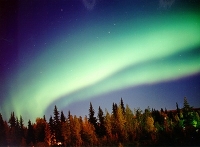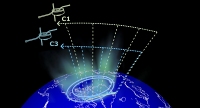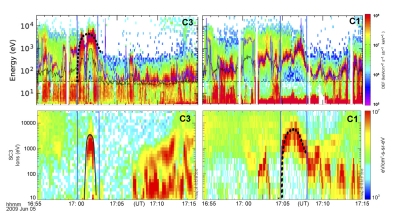First results of Cluster's auroral acceleration campaign
1 February 2011
Auroras, more commonly known as the northern and southern lights, are one of the most beautiful and awe-inspiring natural phenomena. New insights into the processes that generate Earth's auroras (and those of other planets) are now being provided by a flotilla of ESA satellites, known as the Cluster mission, as they sweep through the region of space where these colourful curtains of light are created. As they fly in formation above the planet's poles, the Cluster spacecraft are gathering the first multi-point observations of auroral nurseries. |
| The aurora, or northern lights. Credit: J. Curtis |
"The AAR is a particle accelerator in space, similar to an electron gun in an old TV," said Arnaud Masson, ESA's deputy project scientist for Cluster. "It is fed by electrically charged particles that originate in the magnetotail, an elongated region of the magnetosphere located on the nightside of Earth."
"The AAR is not permanent – it comes and goes," continued Masson. "In the absence of the AAR and Alfvén waves, the aurora is diffuse or spread out, and not always noticeable to the naked eye. When the AAR is present, bright, discrete arcs can be seen, sometimes with 'black auroras' embedded."
The existence of the AAR has been known for decades. However, there are still many open questions about auroras, including the altitude distribution and stability of the electric fields which accelerate the particles inside these regions. Now, by analysing the new data from Cluster, these open issues can be tackled for the first time.
Cluster multipoint studies
Since 2006, the Cluster satellites have slowly drifted away from their initial polar orbits. Meanwhile, the perigees (lowest points) of their orbits have decreased from 19 000 km to just a few hundred kilometres, giving Cluster access to new regions of near-Earth space. For the first time, in Spring 2009, scientists could make use of this natural orbital drift to obtain simultaneous measurements of the AAR with more than one satellite.
 |
| Two Cluster spacecraft crossed the auroral acceleration region on 5 June 2009. Credit: ESA |
At that time, C1 was flying at an altitude of 9000 km, some 2600 km above its sister craft but lagging about 5 minutes behind. Subsequent analysis of data from the EFW electric field and waves, FGM magnetic field, PEACE electron and CIS ion instruments enabled the team to conduct a unique study of the physical state of the AAR during the flybys.
The dual observations revealed spatial and temporal variations in the electric fields and associated particle signatures For the first time it was possible to constrain the size and longevity of these regions. The data showed that the electric field structures measured at least 800 km across and remained stable for at least 5 minutes.
 |
| Measurements obtained with two of the Cluster spacecraft provided new insight into the auroral acceleration region. Credit: ESA |
The measurements also revealed the 2-D morphology and altitude distribution of the acceleration (electric) potential. They showed that two broad, U-shaped potentials at higher altitude formed a single, combined structure with a narrow, S-shaped potential at lower level.
| Using measurements made by the Cluster C3 and C1 spacecraft it has been possible, for the first time, to constrain the size and longevity of the electric fields in the acceleration regions. Credit: ESA (For larger versions of this video click here) |
"The data from this and other events are revealing how the acceleration region and the associated electric potential pattern evolve in time and space, and the time scales over which they can be regarded as stable," said Professor Göran Marklund from the Royal Institute of Technology, Stockholm, Sweden, who is lead author of the paper.
"These new results do not yet provide a complete explanation of the dynamics of the aurora, since the Cluster instruments are not optimised for measuring this region, but they provide important constraints on how these structures are created. They also provide inputs for simulations and for future multi-point missions that will explore near-Earth space. Similar space plasma processes occur throughout the Solar System, so a greater understanding of Earth's auroras has implications far beyond our own planet," he added.
Reference paperMarklund, G.T. et al., Altitude distribution of the auroral acceleration potential determined from Cluster satellite data at different heights, published on 1 February 2011 in Phys. Rev. Lett., 2011
Co-authors of the paper are: Soheil Sadeghi, Tomas Karlsson and Per-Arne Lindqvist (Space and Plasma Physics Department, School of Electrical Engineering, Stockholm), Hans Nilsson (Swedish Institute of Space Physics), Colin Forsyth and Andrew Fazakerley (Mullard Space Science Laboratory, University College, UK), Elizabeth Lucek (Space and Atmospheric Physics Group, Imperial College, London) and Jolene Pickett (Department of Physics and Astronomy, University of Iowa, USA)
Contacts
Professor Göran Marklund
KTH - Royal Institute of Technology
Sweden
Phone: +46 8 790 7695
Email: goran.marklund ee.kth.se
ee.kth.se
Arnaud Masson
Cluster Deputy Project Scientist
Directorate of Science and Robotic Exploration
ESA, The Netherlands
Phone: +31 71 565 5634
Email: Arnaud.Masson esa.int
esa.int
Matt Taylor
Cluster Project Scientist
Directorate of Science and Robotic Exploration
ESA, The Netherlands
Phone: +31 71 565 8009
Email: Matthew.Taylor esa.int
esa.int


